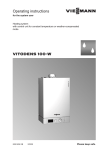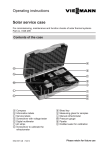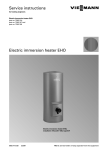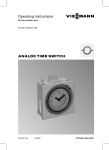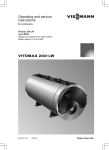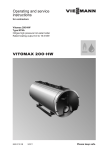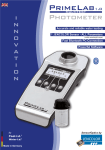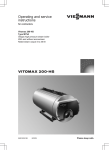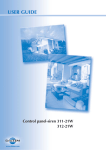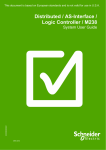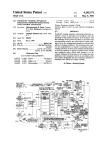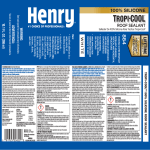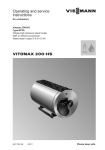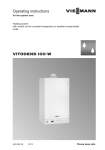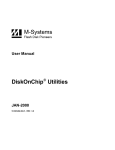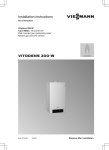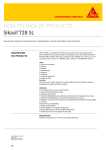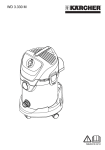Download User Manual - Vitomax 200
Transcript
Operating and service instructions VIESMANN for contractors Vitomax 200-HW Type M238 Oil/gas fired high pressure hot water boiler Combustion output 4.0 to 18.2 MW VITOMAX 200-HW 5592 548 GB 06/2007 Please keep safe. Safety instructions Safety instructions Please follow these safety instructions closely to prevent accidents and material losses. Safety instructions explained Danger This symbol warns against the risk of injury. ! Please note This symbol warns against the risk of material losses and environmental pollution. Note Details identified by the word "Note" contain additional information. Target group These instructions are exclusively designed for qualified personnel. & Work on gas equipment must only be carried out by a qualified gas fitter. & Work on electrical equipment must only be carried out by a qualified electrician. & The system must be commissioned by the system installer or a qualified person authorised by the installer. & the Code of Practice of relevant trade associations, & all current safety regulations as defined by DIN, EN, DVGW, TRGI, TRF, VDE and all locally applicable standards. If you smell gas Danger Escaping gas can lead to explosions which may result in serious injury. & Never smoke. Prevent naked flames and sparks. Never switch lights or electrical appliances ON or OFF. & Close the gas shut-off valve. & Open windows and doors. & Remove all people from the danger zone. & Notify your gas or electricity supplier from outside the building. & Shut off the electricity supply to the building from a safe place (outside the building). If you smell flue gas Observe the following when working on this system & all legal instructions regarding the prevention of accidents, & all legal instructions regarding environmental protection, 2 Danger Flue gas can lead to life-threatening poisoning. & Shut down the heating system. & Ventilate the boiler room. & Close all doors leading to the living space. 5592 548 GB Regulations Safety instructions Safety instructions (cont.) Working on the system & When using gas as fuel, also close the main gas shut-off valve and safeguard against unauthorised reopening. & Isolate the system from the power supply and check that it is no longer 'live', e.g. by removing a separate fuse or by means of a main isolator. & Safeguard the system against unauthorised reconnection. Please note Electronic modules can be damaged by electro-static discharges. Touch earthed objects, such as heating or water pipes, to discharge static loads. ! Please note Repairing components which fulfil a safety function can compromise the safe operation of your heating system. Replace faulty components only with original Viessmann spare parts. Ancillary components, spare and wearing parts ! Please note Spare and wearing parts which have not been tested together with the heating system can compromise its function. Installing non-authorised components and non-approved modifications/conversion can compromise safety and may invalidate our warranty. For replacements, use only original spare parts from Viessmann or those which are approved by Viessmann. 5592 548 GB ! Repair work 3 Index Index Operating information Operating tips ............................................................................................. Operational checks ..................................................................................... Shutdown ................................................................................................... Maintenance information............................................................................. 5 5 6 8 Commissioning, inspection, maintenance Steps - commissioning, inspection and maintenance ................................... Further details regarding the individual steps .............................................. 9 11 Additional information Standard values for water quality ............................................................... 20 Commissioning/service reports ............................................................... 22 5592 548 GB Keyword index .......................................................................................... 27 4 Operating information Operating tips According to the Pressure Equipment Directive 97/23/EC, a steam boiler category IV may only be taken into use when the relevant authority has granted permission for the installation of the system, and an authorised expert has tested the system. The system must be commissioned by the system installer or a qualified person authorised by the installer as well the relevant expert. Record all actual values in a commissioning/service report. These values must be confirmed by the expert and the system user. According to the Pressure Equipment Directive 97/23/EC, hot water boilers category IV may only be operated, supervised and maintained by a trained boilerman. The relevant authority may grant, upon application, permission to operate the boiler without permanent supervision, subject to it being equipped in accordance with EN 12953 part 6. In systems comprising several boilers, of which one is constantly used as standby boiler, only change the operation over in longer intervals, e.g. during the annual inspection of the total system. We would recommend that you operate the boiler constantly at the required operating pressure and temperature. The continued boiler operation is still advantageous, even if no heat is drawn off for a longer period of time. Operational checks Danger Boiler components that are not thermally insulated can be subject to high temperatures that can result in burns. Take care with hot surfaces. 5592 548 GB Subject to the safety equipment fitted and the details in the permit certificate, either monitor the correct boiler operation constantly, every 24 hours or every 72 hours. Determine the extent of checks required in accordance with TRD 601, sh. 1, section 7 [or local regulations]. Test the chemical composition of the boiler water and feedwater constantly in accordance with EN 12953 part 10 and VdTÜV datasheet 1466 [or local regulations]. Carry out the following checks daily or every 72 hours, subject to boiler version and the manufacturer's specification (see also TRD 601, sh. 1): & Blow down the boiler (only for boilers without automatic facility; briefly open the valve two or three times at operating pressure). & Check the water level limiter. & Check the feed and boiler water. 5 Operating information Operational checks (cont.) Carry out the following checks monthly: & Check the function of the safety valve. & Check the function of all control and safety equipment. & Check all connections and closures for leaks. & Check the installation room ventilation. Have someone carry out the following checks every six months (in accordance with TRD 602 and 604): & Check the safety equipment. & Check the burner. & Check the thermal insulation on the hot gas side, i.e. on lids and doors. Record the results of the daily, monthly and biannual checks in a log. Shutdown To prevent corrosion setting in during idle periods, when the boiler is not pressurised, conserve the boiler surfaces on the flue gas and water sides, subject to the length of the period during which the boiler is taken out of use. There is a differentiation between wet conservation (during which exposure to oxygen is to be avoided) and dry conservation (during which moisture levels are to be minimised). Brief interruption of operation (1 to 2 days) Water side Recommendation: Maintain the boiler pressure and temperature. Where that is not possible and the boiler should be depressurised for several days, we would recommend the following: To prevent oxygen corrosion, add an oxygen binder with twice to three times the standard dose to the feedwater from approx. one hour before the boiler is shut down. Flue gas side 5592 548 GB Keep the heating surfaces dry. Remove severe contamination as it binds moisture. 6 Operating information Shutdown (cont.) Longer interruptions of operation Water side Wet conservation, as long as there is no risk of frost 1. Fill the boiler up to the highest possible level with treated feedwater. To prevent oxygen corrosion, add an oxygen binder to the boiler water (e.g. sodium sulphite) in accordance with the manufacturer's instructions. For this, ensure good admixing with the boiler water (thermal or mechanical agitation). 2. If, in multi-boiler systems, only some boilers must be conserved, these can be filled with desalinated boiler water from the boilers that remain in use, which will also maintain the temperature. 3. Maintaining pressure in a fully filled boiler using nitrogen (preferably nitrogen 5.0) of 0.1 to 0.2 bar can prevent corrosion. Dry conservation in case there is a risk of frost or in case of longer idle periods Drain the boiler at a temperature between 120 and 140 °C, then open the fittings on the water side. Dry the boiler thoroughly and fill with desiccant (e.g. silica gel) in accordance with the manufacturer's details. Ensure that the desiccant does not come into contact with the boiler material. Then close the boiler again. Check in regular intervals whether the desiccant is still able to absorb moisture. 5592 548 GB Flue gas side Thoroughly clean and dry the surfaces on the flue gas side. Maintain the alkaline balance of the wash water (pH 8-9, in case of ammonia pH 10). After the surfaces have been dried completely, conserve them with a thin film of graphite or boiled oil. 7 Operating information Shutdown (cont.) Keep the surfaces dry during the idle periods (by inserting desiccant (e.g. silica gel) or by air changes from a connected dryer). Further details For further details, see the operating instructions for conservation on the water and hot gas side or the VdTÜV datasheets (no. 1465, Oct. 1978) and the VGB (no. R116H, 1981) [or local regulations]. Maintenance information Danger Boiler components that are not thermally insulated can be subject to high temperatures that can cause burns. Take care with hot surfaces. 5592 548 GB The maintenance of a high pressure hot water boiler is specified by the TRD [or local] regulations. 8 Commissioning, inspection, maintenance Steps - commissioning, inspection and maintenance For further information regarding the individual steps, see the page indicated ! • Commissioning steps ! • • 5592 548 GB Maintenance steps Page ! • • • • • 1. Starting the heating system . . . . . . . . . . . . . . . . . . . . . . . . . . . . . . . . . . . . . . . . . . . . . . • 6. Extracting (if installed) and cleaning the turbulators . . . . . . . . . . . . . . . . . . . . . . . . . . . . . . . . . . . . . . . . . . . . . . . . . . . . . . . . . . . . . . . . . . . . . . . . . . . . . . . 14 • 7. Cleaning the heating surface, the flue outlet and flue pipe . . . . . . . . . . . . . . . . . . . . . . . . . . . . . . . . . . . . . . . . . . . . . . . . . . . . . . . . . . . . . . . . . . . . . . . . . . . . . . . . . . . . 15 • • 8. Checking all seals/gaskets and packing cords on the flue gas side • • • • 9. Checking the thermal insulation parts . . . . . . . . . . . . . . . . . . . . . . . . . . 15 • • 11. Securing the clean-out cover and the combustion chamber door . . . . . . . . . . . . . . . . . . . . . . . . . . . . . . . . . . . . . . . . . . . . . . . . . . . . . . . . . . . . . . . . . . . . . . . . . 16 • • 12. Installing the burner . . . . . . . . . . . . . . . . . . . . . . . . . . . . . . . . . . . . . . . . . . . . . . . . . . . . . . . . . . . . . 17 • • 14. Checking the inspection ports for leaks . . . . . . . . . . . . . . . . . . . . . . 17 • • 16. Cleaning the sight glass in the combustion chamber doors . . . . . . . . . . . . . . . . . . . . . . . . . . . . . . . . . . . . . . . . . . . . . . . . . . . . . . . . . . . . . . . . . . . . . . . 19 17. Checking the water quality . . . . . . . . . . . . . . . . . . . . . . . . . . . . . . . . . . . . . . . . . . . . . . . . 19 • • • • • • • Inspection steps 11 2. Shutting down the system . . . . . . . . . . . . . . . . . . . . . . . . . . . . . . . . . . . . . . . . . . . . . . . . . 12 3. Removing the burner (if required) . . . . . . . . . . . . . . . . . . . . . . . . . . . . . . . . . . 13 4. Opening the cleaning door(s) . . . . . . . . . . . . . . . . . . . . . . . . . . . . . . . . . . . . . . . . . . . 13 5. Opening the clean-out cover and combustion chamber door . . . . . . . . . . . . . . . . . . . . . . . . . . . . . . . . . . . . . . . . . . . . . . . . . . . . . . . . . . . . . . . . . . . . . . . . . 14 10. Inserting turbulators (if appropriate) and closing the cleaning doors . . . . . . . . . . . . . . . . . . . . . . . . . . . . . . . . . . . . . . . . . . . . . . . . . . . . . . . . . . . . . . . . 16 13. Checking all connections on the water and steam side for leaks 15. Check the function of all safety equipment in accordance with the log for steam boiler systems category IV. . . . . . . . . . . . . . . . . . . . . . . . . . . . . . . . . . . . . . . . . . . . . . . . . . . . . . . . . . . . . . . . . . . . . . . . . . . . . . . 18 18. Checking the installation room ventilation 9 Commissioning, inspection, maintenance Steps - commissioning, inspection and . . . (cont.) ! ! • Inspection steps Maintenance steps Page ! • • 19. Checking the flue pipe for soundness 20. Adjusting the burner . . . . . . . . . . . . . . . . . . . . . . . . . . . . . . . . . . . . . . . . . . . . . . . . . . . . . . . . . . . . 19 5592 548 GB • Commissioning steps 10 Commissioning, inspection, maintenance Further details regarding the individual steps Starting the heating system Details provided by the burner manufacturer and regarding accessories 1. Check that the turbulators (if installed) are fully pushed into the hot gas flues (open the cleaning door(s)). 2. Check that the installation room ventilation is open. 3. Check the function of the water treatment system. 4. Fill the boiler with water and ventilate it. Note The water in hot water boilers must comply with EN 12953 part 10; see also "Standard values for water quality" on page 20. 5. Check all fitted components, such as pipework, valves, regulators, pumps etc. for function and leaks. 6. Check the system pressure. 7. Check the fuel oil level or the gas supply pressure. 11. Switch ON the main isolator, the switch for the boiler drives and the burner control switch in this order (observe the burner manufacturer’s operating instructions). 12. Start the boiler at a low output (max. 30%) and gradually heat up to a temperature of approx. 30 K below operating temperature. 13. After the required flow temperature has been reached, gradually open the boiler return valve and possibly the feedwater valve as well as the boiler flow valve. 14. Only then enable the full burner load. 15. When heating the system from cold (also when restarting after maintenance and cleaning work), prevent all heat transfer to consumers, to clear the dew point range as quickly as possible. 16. After the operating temperature has been reached, sequentially switch on the heat consumers and change over to automatic mode. 8. Open the flue gas damper (if installed). 5592 548 GB 9. Check that the cleaning aperture (s) on the flue outlet is/are closed. 10. Open the gas or oil supply line shut-off valves. 11 Commissioning, inspection, maintenance Further details regarding the individual steps (cont.) 17. Check the fittings for leaks prior to and during the heat-up phase and retighten, where required. Retighten all fittings at max. permissible operating pressure. Torque values under cold and hot conditions: Closure Hand hole Head hole Manhole Dimensions 100 x 150, M16 220 x 320, M20 320 x 420, M24 18. Check the boiler door(s) and clean-out cover after approx. 50 hours for leaks and retighten all screws. Torque 100 Nm 200 Nm 350 Nm Shutting down the system 1. Close the shut-off valves in the oil lines (at the oil tank and filter) or the gas shut-off valve. 2. Switch OFF the burner. 3. Isolate the system from the power supply. 4. Close all valves. 5592 548 GB Danger Opening the boiler connections and openings whilst the boiler is under pressure can lead to a high risk of severe injury. Only open the connections on the water and steam side and inspection apertures after the boiler has been completely depressurised. 12 Commissioning, inspection, maintenance Further details regarding the individual steps (cont.) Removing the burner (if required) 1. Remove the fuel supply line. 2. Undo screws A and remove burner with burner plate B. Opening the cleaning door(s) 5592 548 GB Undo screws A at cleaning door(s) B and open the cleaning door(s). 13 Commissioning, inspection, maintenance Further details regarding the individual steps (cont.) Opening the clean-out cover and combustion chamber door 1. Remove clean-out cover B. 2. Open combustion chamber door A. Extracting (if installed) and cleaning the turbulators 5592 548 GB Remove turbulators A without force. For this, use the turbulator extractor that is part of the cleaning equipment. 14 Commissioning, inspection, maintenance Further details regarding the individual steps (cont.) Cleaning the heating surface, the flue outlet and flue pipe 1. Clean flues A, combustion chamber B and reversing chamber with the brush and remove combustion residues. 2. Remove combustion residues from the flue pipe and the flue outlet. Checking the thermal insulation parts 1. Checking the thermal insulation parts of combustion chamber door A 5592 548 GB 2. Check the thermal insulation parts on the clean-out doors, the combustion chamber entry, the cleanout cover and check inside the reversing chamber. 15 Commissioning, inspection, maintenance Further details regarding the individual steps (cont.) Inserting turbulators (if appropriate) and closing the cleaning doors 1. Insert turbulators B (only in the 3rd flue C) as far as they will go. 2. Close the clean-out doors. 3. Tighten the screws on the cleanout doors A evenly and diagonally. Securing the clean-out cover and the combustion chamber door 1. Tighten down both clean-out covers B so they seal. 5592 548 GB 2. Close combustion chamber door A and tighten it down so it seals. 16 Commissioning, inspection, maintenance Further details regarding the individual steps (cont.) Installing the burner 1. Secure burner plate B with screws A to burner flange C. 2. For pressure-jet gas burner: Fit the gas supply pipe. Danger Escaping gas leads to a risk of explosion. Test the soundness of all gas connections. Checking the inspection ports for leaks Danger Boiler components that are not thermally insulated can be subject to high temperatures that can result in burns. Take care with hot surfaces. Note Replace the gaskets every time a connection has been opened. Insert only gaskets approved in accordance with TRD 401, appendix 1, VdTÜV [or local regulations]. 5592 548 GB Installation instructions of the gasket manufacturer. 17 Commissioning, inspection, maintenance Further details regarding the individual steps (cont.) Check the function of all safety equipment in accordance with the log for steam boiler systems category IV. 5592 548 GB Check the safety valves plus the temperature and pressure limiters in accordance with manufacturer's details. 18 Commissioning, inspection, maintenance Further details regarding the individual steps (cont.) Cleaning the sight glass in the combustion chamber doors Check the sight glass with gaskets A for leaks and clean. Checking the water quality For standard values, see page 20. Adjusting the burner 5592 548 GB By the burner manufacturer or authorised heating contractor. 19 Additional information Standard values for water quality According to the EN 12953 part 10 and the VdTÜV datasheet 1466 regarding the water quality for hot water boilers in heating systems, the following details apply to heating systems operated with flow temperatures in excess of 100 °C: Operation with circulating water with low salt content Only use water with a low salt content as fill or top-up water, such as desalinated water, permeate or condensate. Systems using mixed condensate generally create water with low salt content if no boiler water is fed into the system for putrefaction by alkalies. Operation with saline water Where possible, use water with a low salt content that is at least free from alkaline earths (softened) as fill or top-up water. with low salt content μS/cm 10 to 30 > 30 to 100 General requirements pH value at 25 ºC pH value according to the Drinking Water Order/ Drinking Water Treatment Order [or local regulations] mg/ Oxygen (O 2) (values for constant oplitre eration are generally significantly lower) *1 The Clear, without sediments 9 - 10 ≤ 9.5 Clear, without sediments 9 - 10.5 ≤ 9.5 < 0.1 < 0.05 saline > 100 to 1 500 Clear, without sediments 9 - 10.5 ≤ 9.5 < 0.02* 1 oxygen concentration in the re-circulated water may be up to 0.1 mg/litre, if suitable inorganic corrosion inhibitors are used. 20 5592 548 GB El. conductivity at 25 °C Additional information Standard values for water quality (cont.) Alkaline earths (Ca + Mg) mmol/ litre mg/ Phosphate (PO 4) litre Phosphate (PO 4) accord- mg/ ing to the Drinking Water litre Order/Drinking Water Treatment Order [or local regulations] mg/ Phosphate (PO 4) for Viessmann hot water boi- litre lers When using oxygen binders: Sodium sulphite mg/ (Na 2SO 3) litre (When using other suitable products, observe the respective guidelines issued by the relevant supplier.) with low salt content < 0.02 < 0.02 saline < 0.02 <5 < 10 < 15 ≤7 ≤7 ≤7 < 2.5 <5 < 15 – – < 10 & Methyl ethyl ketoxime (Meko) Tannic acid These must be used with care, however, as they can give rise to oxidation, cleavage and transformation products under boiler operating conditions. Please refer to the above guidelines for further information. & 5592 548 GB The VdTÜV datasheet 1466 advises that further oxygen binders are offered as chemicals that may have the following active ingredients: & Ascorbic acid & Carbohydrazide & Diethyl-hydroxylamine (DEHA) & Hydroquinone 21 Commissioning/service reports Commissioning/service reports Commissioning Service Service Service Service Service Service Service Service Service Service Service Service Service Service date: by: date: by: date: by: date: by: date: 5592 548 GB by: 22 Commissioning/service reports Vitomax 200-HW spare parts Note When ordering spare parts, please quote the serial number and the boiler type (see type plate). Tick the required spare parts and state the number required. Obtain standard parts from your local supplier. B Boiler type: 5592 548 GB A Serial number: 23 Commissioning/service reports Vitomax 200-HW spare parts (cont.) B Boiler type: 5592 548 GB A Serial number: 24 Commissioning/service reports 5592 548 GB Vitomax 200-HW spare parts (cont.) A Serial number: B Boiler type: 25 Commissioning/service reports Vitomax 200-HW spare parts (cont.) B Boiler type: 5592 548 GB A Serial number: 26 Keyword index Keyword index B Burner installation . . . . . . . . . . . . . . . . . . . . . . . . 17 Burner, removal . . . . . . . . . . . . . . . . . . . . . . . . . . . 13 C Cleaning door, opening . . . . . . . . . . . . . . . . 13 Clean-out cover, opening . . . . . . . . . . . . . . 14 Clean-out cover, securing . . . . . . . . . . . . . 16 Combustion chamber door, opening . . . . . . . . . . . . . . . . . . . . . . . . . . . . . . . . . . . . . . . . . . . . . . . . .14 F Fill and top-up water . . . . . . . . . . . . . . . . . . . . . 20 Flue outlet and flue pipe, cleaning . 15 Flue supply line . . . . . . . . . . . . . . . . . . . . . . . . . . . 13 S Safety valve, checking . . . . . . . . . . . . . . . . . . . 6 Saline water . . . . . . . . . . . . . . . . . . . . . . . . . . . . . . . . 20 Shutdown . . . . . . . . . . . . . . . . . . . . . . . . . . . . . . . . . 6, 12 Sight glass, cleaning . . . . . . . . . . . . . . . . . . . . 19 Starting the heating system . . . . . . . . . . . 11 T Thermal insulation parts, checking 15 Turbulators, extracting . . . . . . . . . . . . . . . . . 14 Turbulators, inserting . . . . . . . . . . . . . . . . . . . 16 W Water quality . . . . . . . . . . . . . . . . . . . . . . . . . . . . . . . 20 Water with a low salt content . . . . . . . . . 20 5592 548 GB M Maintenance information . . . . . . . . . . . . . . . . 8 O Operational checks . . . . . . . . . . . . . . . . . . . . . . . . 5 27 Subject to technical modifications. chlorine-free bleached paper Printed on environmentally friendly, 28 Viessmann Limited Hortonwood 30, Telford Shropshire, TF1 7YP, GB Telephone: +44 1952 675000 Fax: +44 1952 675040 E-mail: [email protected] 5592 548 GB Viessmann Werke GmbH&Co KG D-35107 Allendorf Telephone: +49 6452 70-0 Fax: +49 6452 70-2780 www.viessmann.com




























